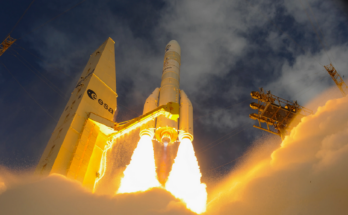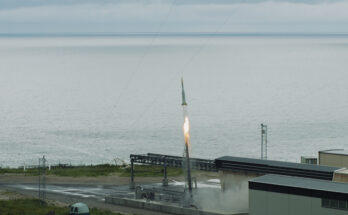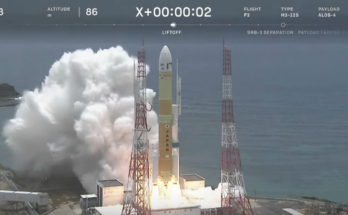by Bill Ostrove, Space Systems Analyst, Forecast International.

On the morning of February 15, 2017, ISRO’s Polar Satellite Launch Vehicle (designated PSLV-C37) launched the 714-kilogram Cartosat-2 Series Satellite and 103 co-passenger satellites from Satish Dhawan Space Centre SHAR, Sriharikota. The launch – which marked the 38th consecutively successful PSLV mission out of 39 flights – was one for the record books.

The total weight of all 104 onboard satellites – 1,378 kilograms – set the world record for payloads on a single launch, easily surpassing the previous record of 37 payloads (carried by a Russian Dnepr rocket in June 2014). Other launch vehicles that have carried a high payload include the Atlas V (31) and Antares (30).
PSLV-C37 lifted off at 9:28 a.m. IST (3:58 a.m. UTC; February 14 at 10:58 p.m. EST) as planned, from the First Launch Pad. After a flight of 16 minutes and 48 seconds, the satellites achieved a polar Sun Synchronous Orbit of 506 kilometers inclined at an angle of 97.46 degrees to the equator (very close to the intended orbit). In the succeeding 12 minutes, all 104 successfully separated from the PSLV fourth stage in a predetermined sequence – beginning with the Cartosat-2, followed by INS-1 and -2.
The primary payload aboard was the Cartosat-2D, the fifth of six satellites in India’s Cartosat-2 series. Based on the IRS-2 bus, Cartosat-2 provides panchromatic and multispectral imagery data with better than 1-meter resolution. After separation, its two solar arrays were deployed automatically, then ISRO’s Telemetry, Tracking, and Command Network (ISTRAC) at Bangalore took control.
Planet (formerly Planet Labs), with 88 3U CubeSats on board, was the PSLV’s other primary passenger. The launch brought the company’s total of in-orbit satellites to 144, enabling it to image the entirety of Earth’s land area every day. While the small size of Planet’s spacecraft do not allow it to capture imagery with the same resolution as competitors such as DigitalGlobe, the size of its current fleet will allow it to update its imagery more frequently.
Additional satellites onboard included eight Lemur spacecraft, owned by meteorological company Spire; as well as experimental satellites from India, Israel, Switzerland, the Netherlands, Germany, Belgium, Kazakhstan, and the UAE.
Competition for lightweight launch vehicles is intense. Retired intercontinental ballistic missiles (ICBMs) dominate much of the market. The PSLV could also face competition from newer launch vehicles, such as the European Vega. However, its reliability and low price tag are attracting international attention. A steady manifest from the ISRO combined with increasing contracts on the international market put it on solid footing.

What makes the February 15 event so significant is that it proved that the PSLV can carry a large number of spacecraft in a single launch. This is an increasingly important capability as the demand for small satellite launch capacity continues to grow. In 2016, the number of satellites launched into orbit actually declined, partially due to a lack of this capacity. The PSLV’s ability to carry small satellites makes it appealing to many universities, companies, and governments. This will generate business for PSLV operator Antrix, as well as launch opportunities for operators of small satellites.
Please feel free to use this content with Forecast International and analyst attributions, along with a link to the article. Contact Ray Peterson at +1 (203) 426-0800 or via email at ray.peterson@forecast1.com for additional analysis.
 Forecast International offers two Space Systems Forecast products: Launch Vehicles & Manned Platforms, with reports on manned spacecraft, expendable launch vehicles and more, and Satellites & Spacecraft, with coverage ranging from microsatellites to large COMSATs – all complete with technical specifications and forecast details.
Forecast International offers two Space Systems Forecast products: Launch Vehicles & Manned Platforms, with reports on manned spacecraft, expendable launch vehicles and more, and Satellites & Spacecraft, with coverage ranging from microsatellites to large COMSATs – all complete with technical specifications and forecast details.
http://www.planet.com/pulse/planet-launches-satellite-constellation-to-image-the-whole-planet-daily/
A military history enthusiast, Richard began at Forecast International as editor of the World Weapons Weekly newsletter. As the Internet grew in importance as a research tool, he helped design the company's Forecast Intelligence Center and currently coordinates the EMarket Alert newsletters for clients. Richard also manages social media efforts, including two new blogs: Defense & Security Monitor, covering defense systems and international issues, and Flight Plan, which focuses on commercial aviation and space systems. For over 30 years, Richard has authored the Defense & Aerospace Companies, Volume I (North America) and Volume II (International) services. The two books provide detailed data on major aerospace and defense contractors. He also edits the International Contractors service, a database that tracks all the contractors involved in the programs covered in the FI library. More recently he was appointed Manager, Information Services Group (ISG), a new unit that encompasses developing outbound content for both Forecast International and Military Periscope.




